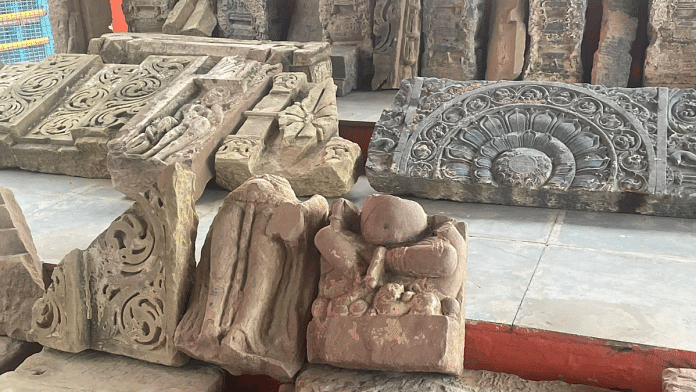Ayodhya: The purported remains of the ancient Ram temple whose pictures were shared last week on social media were found three years ago when excavation took place at the site, ThePrint has learnt.
These remains are “stone” structures and are “adequate” in number, Shri Ram Janmabhoomi Teerth Kshetra Trust general secretary Champat Rai has said, adding that “many more antiquities have been found from the site”.
On 13 September, Rai had posted pictures of half-broken stone structures on social media platform X/Twitter stating that they were “remains of the ancient temple that have been discovered at Shri Ram Janmabhoomi site in Ayodhya”.
“They (the remains) were found three years back when the temple construction had begun and machinery had gone deep inside the ground after removing the debris. They were recovered in June 2020. People who come to have darshan (at the make-shift Ram temple) will see them. What is the need to give this in news? Newspapers have got to know now,” he told ThePrint Tuesday.
Even after June 2020, he said, “a lot has been recovered which no one has seen (earlier).” “Such things have been found which no one has been able to reach (i.e, not shared with media),” he added.
“They are adequate (in numbers). They are not just two-four in number (referring to the photos he shared on social media). As for their period, they will be analysed one day.”
Sharing the tentative date for completion of the Ram Mandir, Rai said that the entire temple construction will take a year and that the preparations required for the proposed pran-pratishtha (consecration of deity idol) in January were limited to the ground floor, work on which is complete.
In June, the temple authorities had said that the ground floor of the three-storey Ram Mandir is in its final stages and that the work on ancillary structures was going on in full swing for their completion by October.
“Only architects can say when and how the construction of the spire will begin,” Rai said to a query about the construction of the ‘shikhar’ (spire) that is traditionally done before installation of the idol.
“Engineers from L&T and Tata are working on the project. It is their first such opportunity to construct a temple by assembling 4.50 lakh pieces of stone, one by one on a 21-ft high granite plinth. They will tell their children about how they did this work. Only those engaged in such work for generations know when they can start (the spire construction),” he said.
The ground floor of the Ram temple will be 380 ft long and 250 ft wide, he said, adding that it is being constructed in the Nagara (north-Indian) style of architecture. Sandstone from Rajasthan’s Bharatpur is being used for construction of the temple in Ayodhya, Rai said.
Also Read: Infra boom to ‘Ramayana’ boat ride, Ayodhya is getting Rs 57,000 crore makeover to match Ram temple
‘All communities contributed to temple fund’
Giving details of the funds being collected for the ongoing construction of the Ram temple, Rai said the contributions came from all communities. “I had not thought anything before starting this (the campaign for fund collection). We had only one thing in mind that God’s home is being constructed…,” he said.
“All communities residing in India — all that come to your mind — have contributed. You can add to that list. (Those staying in) Mizoram are called Christians and their CM says that ‘Ram’ is in the name of Mizoram and the world calls them Christians for no reason. Being a Christian doesn’t mean opposing Ram,” he asserted.
The Ram Janmabhoomi Teerth Kshetra Trust had conducted fund-raising campaigns for construction of the temple that is coming up in Ayodhya. The Vishwa Hindu Parishad (VHP), whose international vice-president is Das, has also actively taken part in fund collection for the shrine.
Rai said the pran pratishtha of Ram Lalla (manifestation of Lord Ram as a five-year-old child) idol will be done between 16 and 24 January. In this regard, Mahant Das said that some priests from Kashi had suggested that the best muhurat (an auspicious moment) for the ceremony is on 22 January.
Last week, Mahant Nritya Gopal Das, the president of the trust and the Ram Janmabhoomi Nyas, had hinted that the ceremony may take place on 22 January.
Mahant Satyendra Das, the head priest of the Ram temple, said that the pran pratishtha of an idol usually takes place after the spire is constructed and a separate pooja of the entire temple is done before that.
“Usually, the spire construction takes place before the pran pratishtha. After the spire is constructed, the entire temple is worshipped and then the pran prathishtha takes place,” he said.
Rai, meanwhile, revealed that the organisation began with an altogether different perspective before embarking on the Ram Janmabhoomi campaign.
“Ram temple was not our dream. Our dream was different — to make Hindustan magnificent in the entire world. There was a time when it used to be worshipped in the entire world as a guru. The dream was to make it even bigger than that. Intellectuals from Hindustan would teach the world with their conduct. and not rule like Europe. We would not go to foreign lands to occupy territories, loot resources and make natives poorer. This is what Europe has done. It finished the native communities,” he said to a query on VHP’s association with the Ram Janmabhoomi campaign.
“Our rishi-munis (sages) travelled all over the world, taught the art of living a good life and then returned home. Our message was Swama Swama Charitram, Shikheram Pratibhyam Sarvamanava (elevate your character to height). That is our goal and Ram Janmabhoomi is a beautiful path towards it, one which has awakened all Indians residing in Hindustan and across the world,” Rai added.
(Edited by Tony Rai)
Also Read: Temple boom, infra burden— how Varanasi, Ujjain, & Ayodhya are tackling surge of devotees



